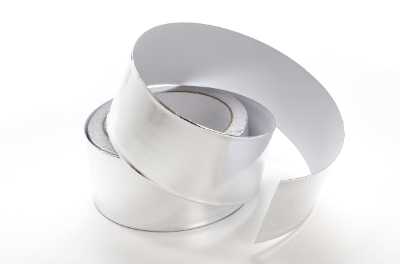What Is Conductive Tape?

Conductive tape is an adhesive tape with a conductive adhesive layer.
The basic shape is an adhesive layer on an embossed metal foil with metal parts exposed on the surface of the adhesive layer, or an adhesive layer containing metal particles placed on top of a metal foil. There are also those with an insulating film placed over the metallic foil to ensure insulation, those with a conductive cloth in place of the metallic foil, and those with a conductive cloth wrapped in an adhesive layer containing metallic particles.
Uses of Conductive Tapes
Conductive tapes are used for antistatic purposes in electronic equipment. In electronic equipment, damage due to static electricity and noise generation and malfunction due to electromagnetic waves are major problems. Therefore, conductive tapes are applied to shield electromagnetic waves to release and eliminate static electricity and to prevent static electricity.
Note that the tape must be attached, so that it is connected to the ground for static elimination when actually used. In addition, conductive tapes that use copper as the metal foil are characterized by high thermal conductivity.
For this reason, it is also used as an auxiliary part of heat dissipation in electronic equipment and devices. Conductive tape using conductive cloth has high tape flexibility and can be applied closely to uneven areas.
Principle of Conductive Tapes
Conductive tapes are available in the form of an adhesive layer on top of an embossed metal foil, with metal parts exposed on the surface of the adhesive layer, or an adhesive layer containing metal particles distributed on top of the metal foil. In this case, metals such as aluminum and copper are used as the metallic foil. Therefore, a part of the embossed metallic foil or metallic particles will come in contact with the adhered area, and static electricity is released from the contacted area to prevent electrification and shield electromagnetic waves.
There are also products with conductive cloth instead of metallic foil, or with conductive cloth wrapped in an adhesive layer containing metallic particles. Polyester or other polymer film containing conductive particles such as metal can also be used in place of conductive cloth.
Conductive tapes with these structures can also shield electromagnetic waves that are released and prevented from being charged by the metal foil, conductive cloth, or conductive particles in the adhesive layer from where they are bonded. Conductive tapes have high shielding effectiveness over a wide range of frequencies, but the shielding effectiveness decreases with decreasing frequency.
Types of Conductive Tapes
Among conductive tapes, conductive carbon tape and transparent conductive tapes are used for special uses of electronic equipment other than antistatic.
1. Conductive Carbon Tape
Conductive carbon tape is a conductive tape that uses aluminum as the main metal foil and an adhesive layer containing carbon powder as a conductive filler. Due to the use of carbon powder, the tape is black.
Conductive carbon tape is often used as a double-sided tape with adhesive layers on both sides of a metal foil and is used, for example, during scanning electron microscopy (SEM) observation. It is suitable for analytical applications because it produces little or no gas.
2. Transparent Conductive Tape
Some transparent type conductive tapes are used in clean rooms. Products without anti-static measures cannot be used in clean rooms. This is because they attract dust and dirt, which are great enemies of clean rooms.
A specific example is a known product consisting of a polybutylene terephthalate resin (PET) base material with a poly-conductive layer and an acrylic adhesive on the outside of the layer. Such transparent conductive tapes have excellent conductivity and transparency, making them suitable as highly adhesive electronic tapes used for packaging static-sensitive components, as well as adhesive tapes with anti-static specifications that suppress peel-off charging.
It is also used as an electrostatic chuck for CMOS, MEMS, power devices, and glass wafers in plasma and CVD processes.
Other Information on Conductive Tape
Soldering Conductive Tape
Metal conductive tapes, such as copper foil tape and aluminum foil tape, are being developed that can be soldered to metal foil surfaces in order to make electrical connections with other components. Conductive tapes are easy to fix to objects because they have an adhesive and are suitable for wiring work using soldering.